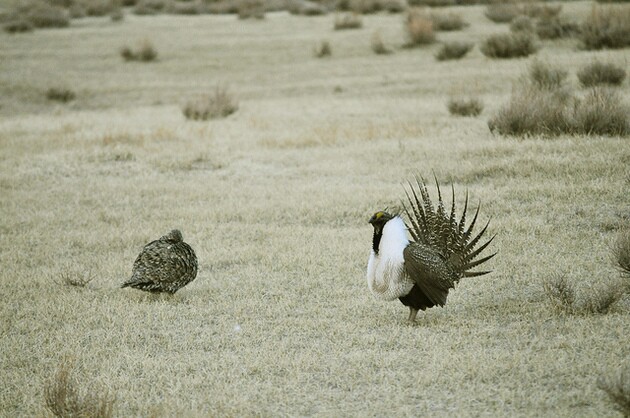Feds Won't Be Protecting California Sage Grouse After All

In a decision already being slammed by wildlife protection groups, the U.S. Fish and Wildlife Service has withdrawn a proposal to list the Mono Basin population of sage grouse as Threatened under the U.S. Endangered Species Act.
The Mono Basin sage grouse, a population considered distinct from the rest of the sage grouse species, is found in a few counties in the California and Nevada portions of the Great Basin desert. Though USFWS proposed listing the so-called "Bi-State Distinct Population Segment" of the grouse in 2013, it's now saying that threats to the unique chicken-sized bird aren't as bad as once feared, and proposed voluntary measures to help sage grouse will be enough.
That decision comes after months of political pressure from the grazing, mining, and development industries that USFWS just last year said threatened the birds. That fact isn't lost on wildlife advocates, who charge that the agency is kowtowing to cow-country business interests.
At an event announcing the decision in Reno, Nevada on Tuesday, Secretary of the Interior Sally Jewell lauded the not-yet implemented voluntary habitat protection measures that will take the place of formal legal protection for the grouse.
Those measures, part of the formidably complex "Bi-State Action Plan," include promises by federal and state agencies, local landowners, tribes and NGOs, and others to maintain and restore habitat for the Mono Basin grouse.
Some of those measures are bound to be controversial within the conservation community, such as cutting down "encroaching" pinyon and juniper woodlands to restore sagebrush steppe, and removal of feral horses to leave more browse for the grouse.
"It's a conservation success story. It has sound science behind it, that's the only way we can make these decisions," said Jewell.
Wildlife advocates don't see it that way. "As recently as December 2014, the Service considered that the magnitude of threats faced by bi-state sage-grouse was so high that the birds were assigned the maximum priority for listing," said Michael Connor, California director of Western Watersheds Project. "The Service's backpedaling in claiming that unfinished management plans and voluntary, cooperative agreements will protect the species is untrue, and smacks of political expediency."
"These birds are in serious trouble, and yet the government is doing nothing to restrict destructive hardrock mining, geothermal development, or off-road vehicle races," added Randi Spivak, public lands director at the Center for Biological Diversity. "Half measures may delay extinction, but they won't prevent it."
For the last decade, according to the Center for Biological Diversity, there have been fewer than 2,500 sage grouse remaining in the Mono Basin population, found only in Mono, Alpine, and Inyo counties in California, and Storey, Carson, Douglas, Mineral, and Esmeralda counties in Nevada. (For its part, the Interior Department disagrees, saying there are as many as 9,000 grouse in the Mono Basin population.) USFWS had proposed to designate almost 3,000 square miles in those counties as critical habitat for the sage grouse. As the species is utterly dependent on uninterrupted stretches of sagebrush habitat for survival and reproduction, protecting it requires that people leave sufficient sagebrush lands unaltered to support the birds.
And that's an unpopular prospect for those who make their money running cattle in sagebrush country, as well as for miners, real estate developers and other powers that be in the Great Basin. As a result, listing of the Mono Basin sage grouse has been a political hot-button issue in the Intermountain West, with many business interests fearing a decision to list the Mono Basin grouse would portend a similar decision on the rest of the species. USFWS is expected to reach a decision on listing sage grouse as a whole later this year.
Wildlife activists are criticizing the Bi-State Action Plan for what it leaves out, including measures to restrict geothermal development currently proposed for 143,000 acres of grouse habitat, as well as a plan to use livestock to control the invasive cheat grass that increases the risk of fire in grouse country.
"Many of the most serious threats to the Mono Basin sage grouse remain unaddressed, and its tiny and isolated populations are under imminent threat of extinction," said Erik Molvar, wildlife biologist with WildEarth Guardians. "Today's decision does nothing to resolve the problems facing this special population, it just punts the issue to the courts."

